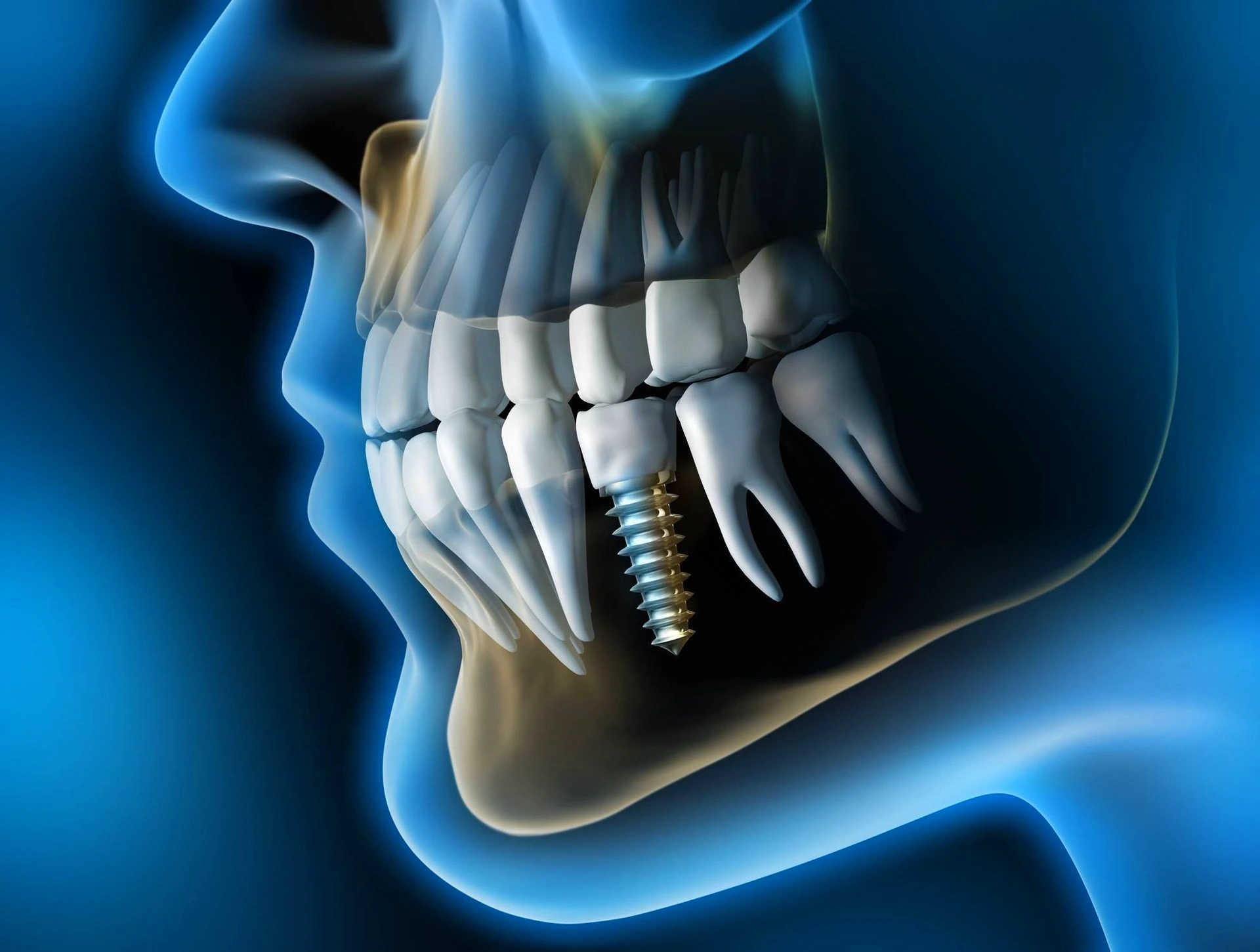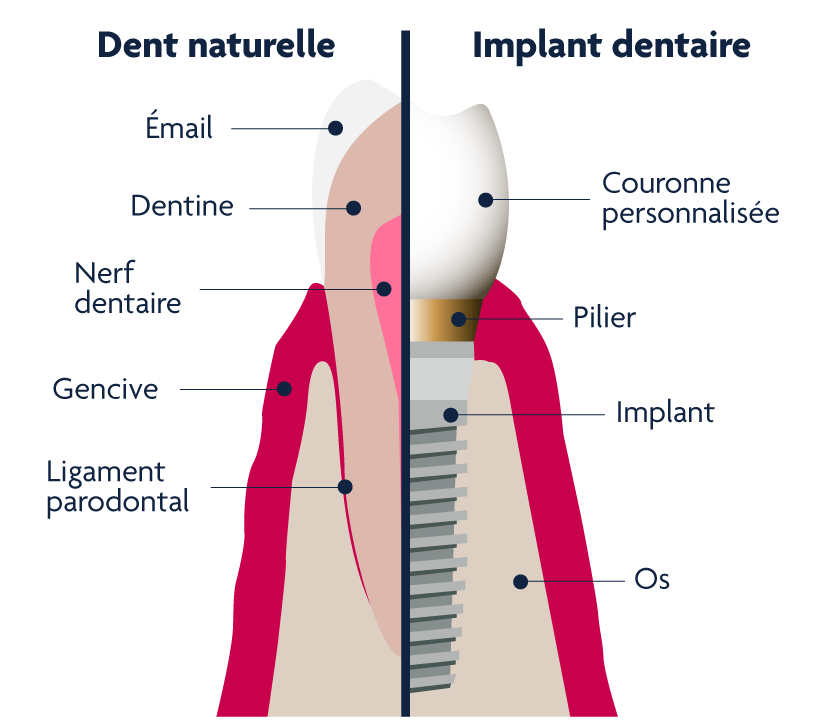Dental implants
A dental implant is a surgical procedure used to replace a missing or damaged tooth. It consists of an artificial root placed in the jawbone, onto which a dental prosthesis, such as a crown, can be attached.
This procedure is performed by Dr. Choaib ZERGA, Director of CDZ (ZERGA DENTAL CLINIC) and Specialist Dentist in Periodontology and Implantology, with 18 years of experience in the field of implantology.

What is its composition?
- The artificial root : This part, also called the artificial root, is usually made of titanium or zirconia. It is inserted into the jawbone during a surgical procedure and serves as a solid foundation for the dental prosthesis.
- The pillar or attachment : Once the implant screw is securely integrated into the bone, a abutment or attachment is fixed on top. This component connects the implant screw to the dental prosthesis, such as a crown or a bridge.
- The dental prosthesis : It is the visible part of the implant, which is attached to the abutment. The prosthesis is usually made of ceramic or composite, and it is customized to match the color, shape, and size of the patient's natural teeth.

What is its composition?
- The artificial root : This part, also called the artificial root, is usually made of titanium or zirconia. It is inserted into the jawbone during a surgical procedure and serves as a solid foundation for the dental prosthesis.
- The pillar or attachment : Once the implant screw is securely integrated into the bone, a abutment or attachment is fixed on top. This component connects the implant screw to the dental prosthesis, such as a crown or a bridge.
- The dental prosthesis : It is the visible part of the implant, which is attached to the abutment. The prosthesis is usually made of ceramic or composite, and it is customized to match the color, shape, and size of the patient's natural teeth.
What are the necessary criteria for placing dental implants?
Several essential criteria determine eligibility for a dental implant, thus ensuring its success and durability.
- General and oral health : Candidates must be in good overall health. Certain chronic conditions, such as uncontrolled diabetes or heart disease, can compromise healing and the success of the implantation. Additionally, rigorous oral hygiene and healthy gums are essential. Issues such as periodontal disease must be addressed before proceeding with the implantation.
- Quantity and quality of the bone : A sufficient bone structure in the jaw is essential to support the implant, which is why it is important to perform a scan during your first consultation. In case of bone loss, procedures such as a bone graft may be necessary before the operation.
- Life habits : Smokers and individuals who consume alcohol excessively are at an increased risk of complications. It is often recommended to modify these habits to maximize the chances of success.
- Age : Dental implants are generally reserved for patients who have reached bone maturity, usually by the end of adolescence or the beginning of adulthood, but they are still possible for older individuals under well-established conditions.
Duration and cost of implantology?
The duration and cost vary depending on several factors, including the number of implants needed and the complexity of the case; these parameters are taken into account during your initial consultation:
A four-step process
1
Initial consultation and planning
- 1 to 2 appointments to evaluate your case (3D scan, dental impressions).
- Duration: 1 to 2 weeks for exams and planning.
2
Implant placement
- Outpatient surgery under local anesthesia.
- Duration: 1 to 2 hours per implant on average.
3
Healing period
- 3 to 6 months for the implant to fuse with the bone.
- During this period, a temporary prosthesis may be used.
4
Placement of the final prosthesis
- Once the implant is stable, the dentist places the crown, the bridge, or the prosthesis.
- Duration: 1 to 2 appointments over 1 to 2 weeks.
How to replace multiple missing teeth? ?
There are several types of dental implants, each suited to specific needs and various clinical situations::

Implant-supported bridges
An implant-supported bridge is a prosthetic solution used to replace multiple missing teeth by anchoring to dental implants rather than adjacent healthy teeth. This approach avoids the need to treat neighboring teeth, thereby preserving their natural integrity.
Implant-supported partial dentures
Implant-supported partial dentures are designed for patients who do not require a full denture but have multiple missing teeth in different areas of the mouth. They are anchored to dental implants, providing a more stable and comfortable solution compared to traditional partial dentures.
Full-arch restorations on dental implants
For patients who have lost most or all of their teeth, the All-on-4 and All-on-6 techniques provide complete restoration solutions. These involve placing four to six implants in the jawbone, onto which a fixed full prosthesis is then attached.
How to replace multiple missing teeth? ?
There are several types of dental implants, each suited to specific needs and various clinical situations::

Implant-supported bridges
An implant-supported bridge is a prosthetic solution used to replace multiple missing teeth by anchoring to dental implants rather than adjacent healthy teeth. This approach avoids the need to treat neighboring teeth, thereby preserving their natural integrity.
Implant-supported partial dentures
Implant-supported partial dentures are designed for patients who do not require a full denture but have multiple missing teeth in different areas of the mouth. They are anchored to dental implants, providing a more stable and comfortable solution compared to traditional partial dentures.
Full-arch restorations on dental implants
For patients who have lost most or all of their teeth, the All-on-4 and All-on-6 techniques provide complete restoration solutions. These involve placing four to six implants in the jawbone, onto which a fixed full prosthesis is then attached.


